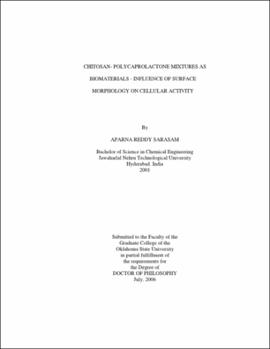| dc.contributor.advisor | Madihally, Sundararajan V. | |
| dc.contributor.author | Sarasam, Aparna Reddy | |
| dc.date.accessioned | 2013-11-26T08:31:42Z | |
| dc.date.available | 2013-11-26T08:31:42Z | |
| dc.date.issued | 2006-07 | |
| dc.identifier.uri | https://hdl.handle.net/11244/7169 | |
| dc.description.abstract | Scope and Method of Study: Chitosan, a naturally occurring polysaccharide has excellent biocompatibility, positive charge and reactive functional groups that help regulate cellular activity, antibacterial properties, and low cost. However, inadequate mechanical strength and incomplete understanding of cell-material interactions have limited its success. Polycaprolactone (PCL) is synthetic polyester that is easy to process, with excellent mechanical properties and tailorable physicochemical properties but lacks bioregulatory properties. Chitosan and PCL were homogenously dissolved in a unique acetic-acid water mixture to obtain a composite that has good biomechanical properties. Uniform membranes were obtained by drying the solutions at 50 degrees C and several processes were explored for forming porous scaffolds, including freeze-extraction and freeze-drying. Membranes were tested for tensile properties under dry/wet, and monotonic/cyclical loading conditions. Support for adhesion and growth of eukaryotes (mouse embryonic fibroblasts) and prokaryotes (Streptococcus mutans and Actinobacillus actinomycetemcomitans) were evaluated in vitro. Cytocompatibility and support for vasculature of scaffolds was tested using CAM assay. Degradation characteristics were evaluated in PBS over 4 weeks. Physicochemical properties and interactions in these mixtures were characterized by DSC, DMTA, FTIR, WAXD, SEM, AFM and EFM. | |
| dc.description.abstract | Findings and Conclusions: Hydrophilic chitosan and hydrophobic PCL were successfully mixed in different mass ratios by dissolution in a unique water-acetic acid mixture. There was no chemical reaction between chitosan and PCL in the prepared mixtures. However, the crystallinity was reduced suggesting partial miscibility between these polymers. Tensile properties of mixture membranes were comparable or better than those of chitosan membranes. These membranes also showed improved viability and spreading of mouse embryonic fibroblasts as well as Gram-positive and Gram-negative bacteria. 3D scaffolds were non-toxic and supported blood vessel formation on CAMs. Evaluation of surface showed increased roughness and positive charge density on the mixtures. Observed changes in biological activity of chitosan were attributed to surface characteristics due to absence of other physical or chemical changes. Therefore, it may be concluded that higher roughness and cationic charge density favor cellular colonization. | |
| dc.format | application/pdf | |
| dc.language | en_US | |
| dc.rights | Copyright is held by the author who has granted the Oklahoma State University Library the non-exclusive right to share this material in its institutional repository. Contact Digital Library Services at lib-dls@okstate.edu or 405-744-9161 for the permission policy on the use, reproduction or distribution of this material. | |
| dc.title | Chitosan-polycaprolactone mixtures as biomaterials: Influence of surface morphology on cellular activity | |
| dc.contributor.committeeMember | Gasem, K. A. M. | |
| dc.contributor.committeeMember | High, Martin S. | |
| dc.contributor.committeeMember | Ford, Warren | |
| dc.contributor.committeeMember | Dewitt, Christina | |
| osu.filename | Sarasam_okstate_0664D_1981.pdf | |
| osu.accesstype | Open Access | |
| dc.type.genre | Dissertation | |
| dc.type.material | Text | |
| thesis.degree.discipline | Chemical Engineering | |
| thesis.degree.grantor | Oklahoma State University | |
